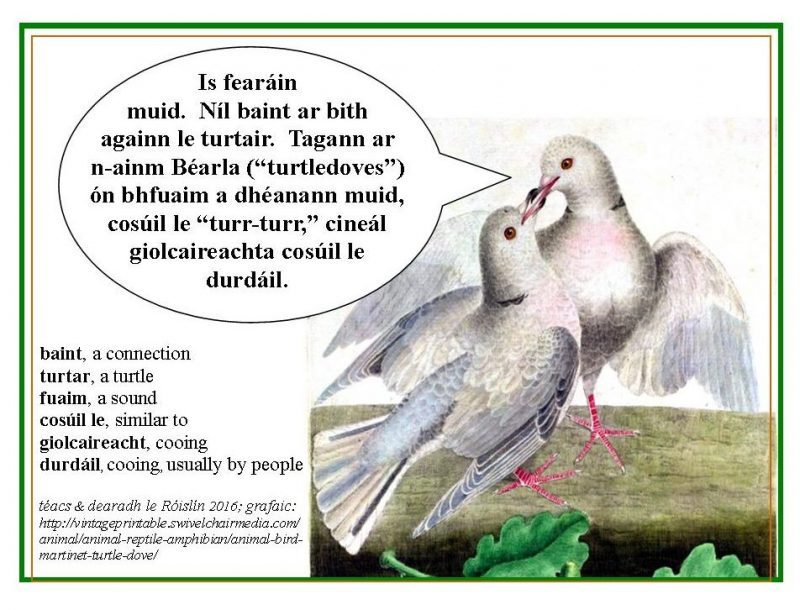Ar an 2ú agus an 3ú lá den Nollaig – dhá fhearán, trí chearc fhrancacha (2 turtledoves, 3 French hens, for the 2nd and 3rd days of Christmas) Posted by róislín on Dec 24, 2016 in Irish Language
(le Róislín)
One partridge and one pear tree down (in the previous blogpost) and the following left to go: fearáin, cearca francacha, lonta dubha, fáinní óir, géanna, ealaí, cailíní bleánaí, mná ag damhsa, tiarnaí, píobairí agus drumadóirí. Although the meaning of the fourth verse is often disputed, I’m going with “lonta dubha,” since early versions of the songs refer to “coaly” (i.e. black) birds.
Although various previous blogposts (naisc thíos) have discussed these, today’s will look once again at the “fearáin” and the “cearca francacha,” with a few grammar and pronunciation notes.
fearán, a turtledove
fearáin, turtledoves
dhá fhearán [ɣaw AR-awn], two turtledoves. The gamma sign (ɣ) is the voiced velar fricative, for which there is a description at the link given below (sa nóta) and in various other blogs in this series; loosely speaking it’s like a deep guttural “h. The “fh,” as usual, is silent. Notice also that while the plural form, fearáin, has an “-áin” ending, we drop that ending after a number. This is an important and general rule in Irish: nouns remain singular when they come right after a number. This will be important for this song, as we proceed further down the lists, and it applies broadly to Irish, if you want to say things like “two cats” (dhá chat, although the plural is actually “cait”) or “ten dogs” (deich madra, although the plural is actually madraí).
And for the cearca francacha (French hens), the same pattern applies:
cearc, a hen
cearca, hens
trí chearc [trzhee hyark, with the “hy” like the “h” in English “humid” or “human” or “hew”], three hens. Note that we drop the plural ending (the final “-a”) for use after a number.
And since these aren’t just any hens, we need to include the adjective, francach, which will get lenited and pluralized.
trí chearc fhrancacha [… RANK-ukh-uh], three French hens. The “fh” is silent and the “ch” is the voiceless velar fricative, found, for example in German “Buch,” Welsh “Bach,” and Yiddish “Chutzpah.” In Irish, when an adjective follows a noun that follows a number, it’s considered plural, even though the noun itself is singular! Always struck me as aisteach! And adjectives in this position are lenited, so “madraí dubha” becomes “deich madra dhubha” and “cait bhána” becomes “dhá chat bhána.” In the latter case, “bán” would already be “bhána,” but the lenition is for a different reason.
So that’s our patraisc amháin, dhá fhearán, and trí chearc fhrancacha. Níos mó bronntanas le teacht sa chéad bhlagmhír eile. Hope it was fun and informative — SGF — Róislín
Nóta re: an fhuaim “dhá”: As mentioned previously in this blog, this is similar to but deeper than the “ch” of German “Buch,” Welsh “bach,” and Yiddish “chutzpah.” There’s no exact equivalent in English, or for that matter, in many other European languages. For starters on the “dh,” try “Saying “I love you” in Irish and Minding Your Velar Fricatives (9 Meán Fómhair 2011) at https://blogs.transparent.com/irish/saying-i-love-you-in-irish/] An example of this sound that I recently noticed, outside of its use in Irish and Scottish Gaelic, is in the name of the young Dutch singer Amira Willighagen of Holland’s Got Talent fame. If you listen carefully, you can hear the /ɣ/ sound and you can also hear it in the name of her hometown (Nijmegen), which you can hear on Wikipedia or on Forvo. It wouldn’t surprise me if many English speakers pronounce her name with a standard English “g,” but apparently that’s not the actual pronunciation. Maybe some Dutch speakers here can suggest a few other basic Dutch words that have this sound — especially if they’re well-known words, as, for example, in place names.
Naisc (Iarbhlaganna ar “Dhá Lá Dhéag na Nollag”
2010: Dhá Lá Dhéag na Nollag (The Twelve Days of Christmas), Posted on 25. Dec, 2010
2010: Cearca Francacha agus Lonta Dubha (Cuid a Dó don tSraith: Dhá Lá Dhéag na Nollag) Posted on 29. Dec, 2010
2010: “Ór,” “Óir” or “Órga”? “Fáinne” or “Éan”? Éan?! (Cuid a Trí: Dhá Lá Dhéag na Nollag) Posted on 31. Dec, 2010
2011: Géanna agus Ealaí (Cuid a Ceathair: Dhá Lá Dhéag na Nollag) Posted on 04. Jan, 2011
2011: Na hUimhreacha Pearsanta i nGaeilge (Irish Personal Numbers and Cuid a Cúig or the Last Installment of Dhá Lá Dhéag na Nollag) Posted on 06. Jan, 2011
2012: Bunuimhreacha, Orduimhreacha is Maoluimhreacha — A Thiarcais! (Oh my!) Posted on 25. Dec, 2012
2013: Speaking of Pigeons (Colúir)Posted on Dec 14, 2013
2013: (Cé Mhéad Patraisc? Cé Mhéad Drumadóir? (or ’12 Lá na Nollag’ Redux and an Irish Counting Lesson to boot) Posted on 18. Dec, 2013
2015: The Irish Twelve Days of Christmas Redux Redux with a Blogliography of Other Blogs on the Song Posted on Dec 25, 2015
2016: Cén sórt éin? Cén sórt crainn? — Learning Irish from the Christmas Carol ‘Dhá Lá Dhéag na Nollag’ (12 Days of Christmas) Posted on Dec 20, 2016

Build vocabulary, practice pronunciation, and more with Transparent Language Online. Available anytime, anywhere, on any device.





Leave a comment: